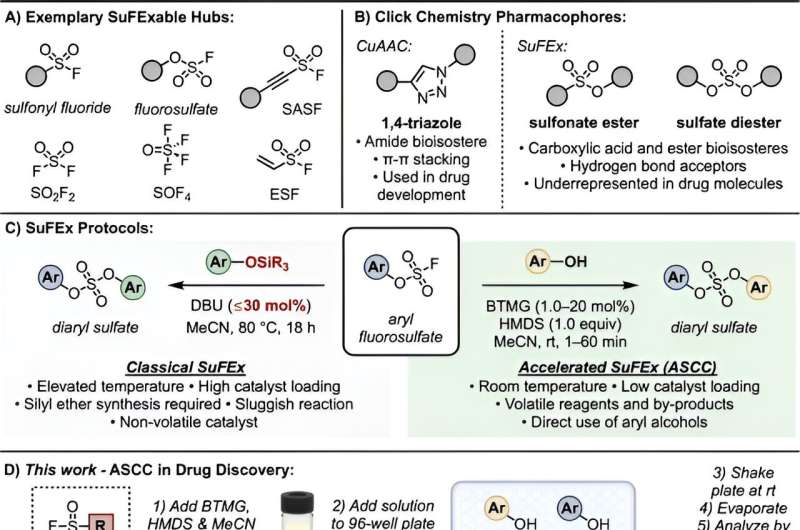This article has been reviewed according to Science X's editorial process and policies. Editors have highlighted the following attributes while ensuring the content's credibility:
fact-checked
peer-reviewed publication
trusted source
proofread
Click chemistry: Research team creates 150 new compounds

Cold Spring Harbor Laboratory (CSHL) chemists have created a new collection of molecular compounds and begun testing them as potential leads in the search for new drugs. Among these molecules, they found several that show promise for development as antibiotics and cancer therapies. Sounds like a eureka moment? Well, sort of. But it's more a case of hard chemistry made simple.
The new compounds were synthesized using an efficient new way of linking molecules together, developed in the lab of CSHL Professor John Moses. Moses calls his innovative process Accelerated SuFEx Click Chemistry (ASCC). It's one of the latest advances in the Nobel-winning field of click chemistry, pioneered by Moses' mentor, K. Barry Sharpless.
Click chemistry quickly snaps together molecules to create complex new structures. This enables drug developers to assemble large numbers of compounds for further exploration. With Accelerated SuFEx, click chemistry can generate more compounds in fewer steps and with higher yields.
"If you can make molecules, you can test them," Moses explains. "And with this technology, you can make them fast."
Moses and his team used ASCC to create more than 150 individual new compounds, including derivatives of complex natural molecules. In the past, it might have taken months to generate and purify such an assortment of molecules. Moses and his team had them ready within days. They then tested these new molecules on cancer cells and drug-resistant strains of bacteria.
In one set of experiments, Joshua Homer, a research investigator in Moses' lab, synthesized an array of molecules that were similar to an anti-cancer compound called combretastatin A4. Homer found that two of the new molecules could kill cancer cells that typically resist standard chemotherapy. These molecules could someday lead to a solution for difficult-to-treat types of breast and pancreatic cancers.
The researchers also created molecules that resembled an antibiotic called dapsone. They saw that some of these molecules were effective against dapsone-resistant bacteria. Homer says ASCC could help chemists reengineer other complex antibiotics to overcome pathogens' hardened defenses.
Looking ahead, Moses and his team will continue to use ASCC to explore new horizons of drug discovery and fine-tune their leads into potential drug candidates. Meanwhile, they hope other researchers will also introduce Accelerated SuFEx technology to their own drug discovery platforms.
Summing up the advantages of ASCC, Moses says, "It's just a way to find function. You can always improve things and optimize them. But let's get there as quickly as possible. Hopefully, we can accelerate the whole process."
The research is published in the journal Chemical Science.
More information: Joshua A. Homer et al, Modular synthesis of functional libraries by accelerated SuFEx click chemistry, Chemical Science (2024). DOI: 10.1039/D3SC05729A
Journal information: Chemical Science
Provided by Cold Spring Harbor Laboratory




















